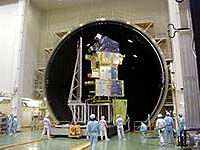
making a big bird
 making a big bird |
By Atsushi Ishizuka
Director, Industrial Collaboration Dept
The International Space Station (ISS) would require about 11 tons of food, water and oxygen per person per year, with a considerable amount of transportation costs. A project was started to reduce these costs by realizing a self-sufficient recycling system within the ISS module of waste products such as excrement, carbon dioxide and waste water.
Theoretically, it could be possible to recycle water and oxygen, and only food would need to be transported to the ISS. JAXA has developed and patented the advanced wet-oxidation waste management technology, which resolves organic waste into an inorganic solution and carbon dioxide; water purification technology that uses adsorbents and reverse osmosis membranes; and carbon dioxide reduction technology that produces methane and water from carbon dioxide.
It is called "Spin-Off" to apply space technologies to non-space industries. JAXA's responsibility includes contributing the outcome of research and development activities to society, and plays a very important role in industrial collaboration. Overseas space agencies - the European Space Agency and NASA - have also recognized the significance of spin-off technology, and their spin-off technologies with their inventions have been used for such things as fireproof and heat-resistant clothing, and sporting goods.
In the past, the main purpose of patent registration was simply for a company to protect their invented technologies. In the last twenty years, however, their recognition of patent has changed. Today, Japanese companies are seeing the importance of intellectual property rights and promoting licensing or cross-licensing to lead to further innovation.
In the 1980s, Japanese manufactures dominated the world market with competitive products by their own well-established manufacturing system. Through the introduction of advanced Western technologies after the Second World War, Japan had constructed its own manufacturing base, focusing on large-scale mass production.
For decades, this had supported the rapid economic growth. In the 1990s, however, that growth came to an end. Other Asian countries had made big advances.
Thanks to lower labor costs, improved production techniques and advanced information technology, they were able to produce products, with reasonable quality at more competitive price, and penetrated into the Japanese market to some extent. As a result, Japan's manufacturers had to relocate their factories to other Asian countries, such as China, which triggered deterioration of Japan's industries in part.
These drastic socio-economic changes brought about the new stream of intellectual property. The lack of encouragement of technological innovation had prevented Japan's continuous economic growth and damaged its international competitiveness.
To try to solve this problem, Japan launched its pro-patent policy, as the United States had done in the 1980s. In 1998 Japan enacted the Law Promoting Technology Transfer from Universities to Industry (the TLO law), an umbrella law with 36 TLOs working under it.
The government also brought in the Revised Industrial Revitalization Law (similar to the U.S. Bayh-Dole Act), and came out with new programs such as Business Innovation Research (similar to the U.S. Small Business Innovation Research program), and "1000 Ventures Born in Universities."
Japan has become aware of the importance of intellectual property, and last year enacted the Intellectual Property Basic Law, to protect creative and intellectual property and to encourage industrial development.
The Organic Waste Recycling System is a good example of JAXA's intellectual property. Moreover, JAXA has many others that have the great potential for immediate commercial application. One example is our "Light-Weight Heat-Insulating Resin Composition", which was invented in the course of the development of a new rocket faring.
This material has excellent adhesiveness, strength and heat-resistance, and is expected to be used in electric heaters, other heating apparatus, and building materials. Another example is "Products on Low Density Thermal Protection System". This is quite a new technology that makes it easy to create low-density homogeneous porous thermal insulation structure - which is heat resistant and heat-shock resistant to over 1200 degrees(c) - something that was impossible in the past.
Last October, JAXA's Industrial Collaboration Department formed a special team to promote the use of intellectual property.
Related Links
 Washington - Jan 19, 2004
Washington - Jan 19, 2004SPACE.WIRE |